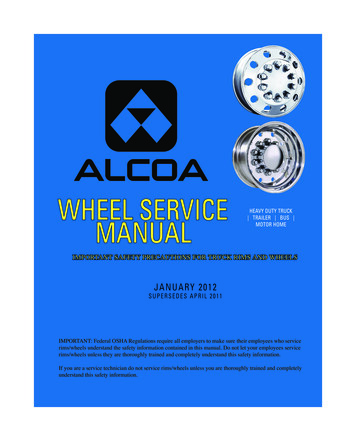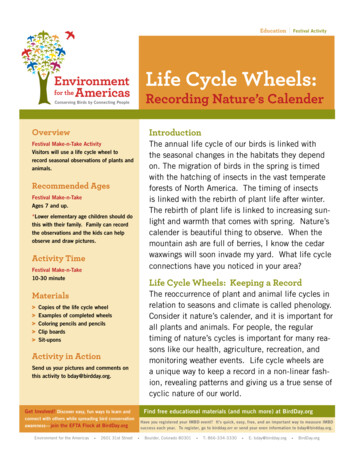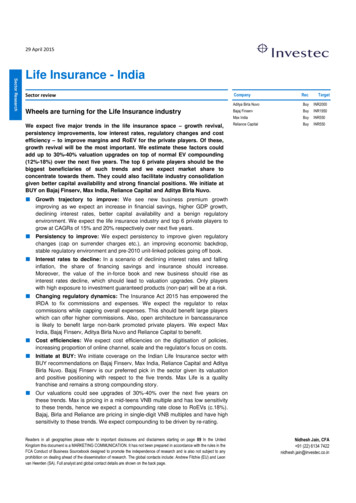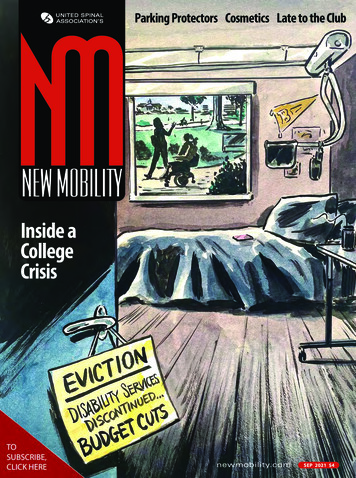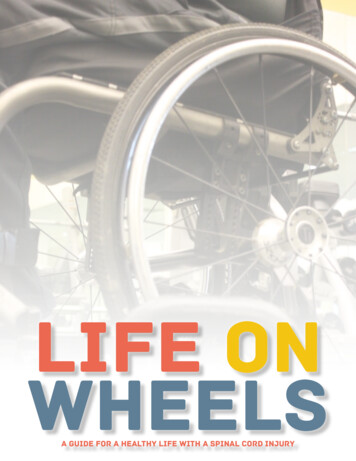
Transcription
LIFE ONWHEELSA Guide for a healthy life with a spinal cord injury
Inside this GuideFitness Components4Designing a Program8Nutrition10Health Complications12Wheelchair Basics 14Sports Chairs16New to a Wheelchair?If you are new to using a wheelchair it can become pretty overwhelming and challenging to relearn how to do everything froma seated position. But while your view of life may have changed(literally), it certainly doesn’t have to be limited. The most important thing to get you active and independent is your health. This includes physical activity and nutrition.“Life on Wheels” is a toolkit designed to help you navigate this newlife and break down all the barriers and myths you might face alongtheway. It will help guide you through becoming active and independent, as well as show you what you need if you want to take it tothe next level.What you choose to do from here on out will make a big impact onyour life. Your health can dictate so many things, like being able totransfer in multiple situationsor traverse different terrains. Don’t let it hold you back fromdoing what you want to do.Barriers to Exercise:There’s no need to start with excuses; not only have we heardthem all, but we have studied them all as well. Typically, thebiggest barriers to exercise you will face include transportation, cost, not knowing where or how to workout, motivationand self efficacy. This Guide will provide you options for bothat home and in gym workouts, as well as resources to be prepared when you do hit the gym. Lack of motivation is certainlynot limited to individuals who use a wheelchair, but you do haveone motivating factor that others might not: your independence!
General Safety Before you BeginStop exercising if you experience pain, discom-fort, nausea, dizziness, lightheadedness,chest pain, irregular heartbeat, shortness ofbreath, or clammy hands.Drink plenty of water.Wear appropriate clothing.Follow an exercise program that meets yourgoals.Blood Pressure Numbers:120/80: Normal Blood Pressure120-139/80- 89: Pre-Hypertensive140-159/90-99: Stage 1 Hypertensive 160/100: Stage 2 HypertensiveCheck with your doctor before starting an exercise program if you areStage 2Check your blood pressure and blood sugar lev-elsbefore exercising to make sure they are at acceptable levels.Physical Activity is for Everybody!Preliminary Steps to ExerciseInform your physician or primary care giver thatyou are considering starting an exercise program.If possible, participate in exercise testing to determine your current level of fitness.If you take any medications, learn the effects theymay have on or from exercise.If possible, consult a trained exercise professionalbefore beginning your program.
Myth: I can’texercise. I usea wheelchair.Now that you are using a wheelchair to getaround, it is important that your exercise routineprovides you with the strength you need to beas independent as possible. Exercise can make ahuge impact on your life by helping you transferindependently and push your own chair. In return,those two things can open up a whole world of activities that you will be able to do. So don’t believethe myth and get started on an exercise programtoday!Fitness ComponentsAerobic Training:You need at least 30 minutes of cardiovascular activitymost days of the week for general health benefits. However, if you want to lose weight or improve mobility it willrequire about 60 minutes most days of the week.Check the box for a list of appropriate aerobic activitiesthat you can do. Not all activities are created equal. Themain thing to watch out for is intensity level. Make surethat whatever exercise you do is actually making you work.Don’t have 30 minutes?Getting bouts of exercise in5 to 10 minute incrementscan also be beneficial. Justtry to add multiple bouts inone day!Aerobic Activities Include:Arm BikeHand CyclePushing BrisklyRowingSeated AerobicsCircuit TrainingSwimmingWheelchair SportsWheelchair Racing“Talk Test” for Aerobic Exercise:If you can sing during the exercise, you aren’t workinghard enough.If you can talk while stopping occasionally to take deepbreaths that is good.If you can’t talk at all your intensity is too high.
Strength Training:This component can make a huge impact on your activities of daily living and make it easier to getaround in general.A typical strength training programs includes all the majormuscle groups and some smaller groups important to chairusers. You want to perform each exercise at least 10 times. Ifthat gets easy start doing 2 or 3 sets of 10 repetitions of eachexercise. Major muscle groups include biceps, triceps and backmuscles. Which muscles you are able to work will be differentfor everyone. Active movement means you are doing the work,while passive movement means someone else is doing it foryou. Active movement is great to increase muscle strength,while passive movement should just be used in range of motionexercises and not involve a lot of weight. If you get stuck tryingto work a muscle group, try to think outside of the box to makethat movement happen.Flexibility Training:Full body flexibility is one component that is oftenneglected in individuals with spinal cord injuries.Having a good flexibility program can help with circulation in your extremities that may have reducedblood flow. It can also help with counteracting thestiff position that comes with sitting in a wheelchairall the time. Being able to straighten your legs fullyor flex your feet can help you in many situations,including transfers.A good flexibility program should stretch all the major muscle groups.Starting out, you should hold each stretch for at least 10 seconds. Gradually work your way up tolonger periods of time, holding some stretches all the way up to a full minute. You should performat least 2 reps of each stretch. On the second rep try to get a little bit further on your stretch. Yourflexibility program can be performed most if not all days of the week and multiple times a day. Onekey point to remember is: never stretch a cold muscle! Make sure you’ve done something to warmthose muscles up, like pushing, before you stretch.For a video on inclusive yoga go to NCHPAD’s YouTube channel.
Tips and TechniquesIf you do have access to a gym there are a tonof different options available to you. However,some of these options may require some extraequipment, and if the gym doesn’t provide ityou may need to bring it with you. In this section we will go over strength training tips andtechniques to help you get the best workoutpossible.Strength Training OptionsThe gym you attend may or may not have accessible pieces of equipment but don’t let thathold you back. Your first option is to transferonto their machines. It can actually be verybeneficial to get out of your chair and work offtheir machines because it will make you engageyour core. This is another reason why beingable to transfer independently is so important.Your second option is to use a cable column. Acable column can be found in almost any gymand it will allow you to work multiple musclegroups all from the same location. You shouldbe able to adjust the cable up to perform latpull downs, triceps extension, and straight armpull downs. Putting the cable at chest heightallows you to perform chest press, rowing, andinternal external rotations. Finally, lowering thecable down allows you to perform bicep curls,upright rows, and shoulder press.Your third option is free weights. Free weightsallow for multiple angles , range of motions,and variety! To avoid injury make sure you areusing proper form for all exercises.Strength Training Tips:Straps: Straps can be used in multipleareas. They can be used to strap your legstogether to provide stability, around yourchest to provide balance, or anywhereelse they might be helpful.Cuffs: Cuffs can come in all differentshapes and sizes. If you have difficultywith grip strength, cuffs will allow you tomove the weight without having to hold it.Ace bandages: If you don’t have a lot ofgrip strength, these can be used to keepyour hands attached.
Push vs. PullIf you are one that likes to go to the gym every day, you wantto make sure that you aren’t working the same muscle groupsevery day. There are a couple ways you can avoid this. Splityour exercise days into “push and pull” or “front and back.”Using the push vs. pull method, you would work all the muscles that you use to pull something on one day and then use allyour pushing muscles the next. You can also split your routineby doing the muscles on the front of your body and muscles onthe back.Push and pull muscles are also important for another reason.If you are a chair user then your “push” muscles are sure tosee plenty of action. The more you push the more roundedyour shoulders and hunched your back will become. Your goalshould be to combat these effects when in the gym. Start withthe pull moves that usethe largest muscle groupsand work your way downto smaller muscle groups.Keep in mind that smallermuscle groups won’t require a lot of weight so besure not to over stressthem.Think Outside the BoxSo maybe you can’t do some exercises the way you useto, but that doesn’t mean you can’t do the exercise at all.There are plenty of ways to do things that will still get youthe same effect. For instance, maybe you can’t do a regular push up anymore because you can’t hold your hips offthe ground. Instead, try doing them offa mat. To increase the work load comeas far off the mat as you are able to andstill perform a push up. For other exercises, you may have to strap yourself toa bench if you don’t have enough corestrength or control to hold yourself upand perform the exercise. Some exercises that you used to do standing maynow need to be done lying down, like reverse flys. Dips are a very good exerciseto help you with your transfers. You can practice these bygetting between two chairs.All Pull—No PushWorkout Routine3 sets of 10 repsPull UpsRowingLat PulldownsDumbbell PulloversDiagonal Kettlebell SwingsReverse FlysScapular RetractionsExternal RotationsPlanksFor more high intensity inclusive exercises, check outChampion’s Rx atwww.nchpad.org/crx
Designing a ProgramWhat does this all mean for you ?Without a proper fitness program your life on wheels can beharder than it has to. A regular exercise routine will not onlyhelp you feel and look better; it will also produce mental benefits, decrease stress, and increase self esteem. Even if youare starting from scratch or aren’t very athletic, there are stillthings you can do to increase your health. The first thing youneed to do is:Start Moving: Transfer out of your chair more, push aroundyour neighborhood or mall, or do some light chores aroundyour house. The main emphasis is moving and doing it yourself,whatever “it” may be. Even just 5 minutes a day can start tomake a difference!Benefits of Exercise:Decrease blood pressureIncrease mobilityDecrease cholesterol levelDecrease risk of cancersLook betterFeel betterMove betterWeight controlOnce you are ready to start a fitness routine, it’s as easy as 1 2 3.1231. Warm UpThis is any light movement that slowly increases your heart rate and gets your muscles warm, suchas an easy push or light arm bike routine.2. ExerciseThis should consist of at least 30 minutes of large muscle continuous movement. Your heart rateshould remain elevated. Examples include handcycling, arm biking, pushing, and swimming.3. Cool DownDon’t abruptly stop your workout; instead, slowly bring your heart rate back down by doing somelight movements similar to thoseused in the warm up.Want some help?Check out NCHPAD’s “14 Weeks to aHealthier You” program, a personalized, web-based physical activityand nutrition program primarily forindividuals with physical ored exercises*Motivational resources*Social networking*Email reminders
No Gym, No Problem!If there is no gym in your area or you don’t havethe time, money, or transportation to get thereyou can always workout at home.Body weightexercises or using items aroundyour house are agreat way to buildstrength withoutany weight equipment. Things likepush ups and dipsare great at working the musclesyou need to getaround and transfer.Another option is light calisthenics. This justmeans body movements that get your heartrate up. Examples are arm jacks, arm circles orpunching motion.Ready to take it up a notch?Do those same exercises Tabata style. Thismeans you will do each exercise for 4 minutes, doing 20 seconds of work followed by10 seconds of rest repetitively for the full 4minutes.You can also add exercsises like push ups,dips, and mountain climbers for the arms.Check out NCHPAD’sYouTube channel formore options.HOME WORKOUTComplete 3 sets of 10 repetitions for eachexercise.Chair push ups: Using your wheelchair or achair with arms, place your hands slightlybehind you on the arms and push up untilyour elbows are fully extended and yourbody comes out of the chair.Arm circles: Hold your arms straight out tothe side and perform a circular motion withboth.Biceps curls: Using a soup can, start witharms down by your side, then curl yourarm up to your shoulder.Sitting wall pushups: Place a stationarychair next to a wall. Place your arms atchest height with elbows bent on the walland then fully extend your elbows, pushingyour body away from the wall.Arm jacks: Perform the motion of a jumping jack with just your arms.Shoulder press: With a soup can in eachhand, start with your hands at shoulderheight and push straight upSeated crunches: From a seated position,bend over and try to touch your toes, thenbring your arms up and fully extend themover your head.“You are only limitedby your imagination.DREAM BIG”
Nutrition 101Did you ever think that what you were eating could have a negative effect on how muchfun you were having or how independent you were? Well it could. The foods we eat play arole in how we feel each day depending on whether we have eaten too much, not enough,or whether we have chosen the right foods for our body. Proper nutrition may be a key toimproving your physical ability.Nutrition is such a vital component to your health, yetit is one that very often gets left out. In this section wewill try to break it down into simple components. Implementing and maintaining a good diet will be key to whereyou go from here.Balance your calories: Enjoy your food, but eat in moderation. Avoid any super-sized or over-sized portions.Foods to increase: Half of your dinner plate should befruits and vegetables. Make sure half of your grains arewhole grains. Make the switch to fat-free or 1% milk.Foods to decrease: Choose foods with lower sodium,particularly when selecting canned foods and frozenmeals. Drink water instead of sugary drinks like soda.How big is your dinner plate? Keeping your dinner plate9 inches or less can help guarantee portion control.For more information check out www.nchpad.orgMyth: EatingHealthy is TOOexpensive.Benefits of good nutrition:Decreases blood pressureDecreases cholesterolDecreases risk of certain cancersDecreases risk of diabetesDecreases risk of heart diseaseMaintains healthy immune systemImproves body compositionKey to weight loss (which can helpmake your activities of daily living andtransferring much easier)Helps provide energy for activityPromotes healing of UTI’s and skinbreakdownsAND SO MUCH MORE
Top 10 Nutrition Tips:1. More fruits and vegetables; aim for 5 servings each day2. Choose whole grains3. Limit the consumption of red meat andprocessed foods4. Choose lean protein such as chickenand fish5. Eat breakfast every morning6. Drink water with each meal and snack7. Small portion sizes8. Limit drinking sugar-sweetened beverages like soda and fruit juices9. Limit creamy sauces and high fat condiments like butter and sour creamFor more information go to: www.choosemyplate.gov10. Between meals, choose healthy snacks like fresh veggies, fruit or low-fat yogurtGoal WeightHere is an equation to determine the amount of caloriesyou need to maintain your current weight.Individuals with Paraplegia: 27.9kcal x kilograms of bodyweightIndividuals with Quadriplegia: 22.7 kcals x kilograms ofbody weightStart subtracting 500–1,000 calories from whatyou are currently eatingto start losing weight.(To convert pounds to kilograms: pounds / 2.2 kilograms)To determine the amount of calories you need for weightloss, use your adjusted ideal body weight instead of yourcurrent weight.Go to NCHPAD.organd search “BMI calculator” to calculateyour BMI
What’s your Goal?Our goal is to help you be ashealthy and independent asyou can. We want you to befit for all your functions ofdaily living and then some.We also want to help youreduce the risk of secondary conditions like diabetes,obesity, and heart diseasethat are common in chair users. Knowing what your goals are is very important to helpkeep you motivated and on track. Write down your goals andplace them somewhere you can see them every day. Whether it’s to transfer independently or push through your neighborhood, understanding the basics laid out here will help youget there.SMART GOALS lth ComplicationsThere are numerous healthcomplications that youshould be aware of nowthat you are a wheelchairuser.SKIN BREAKDOWNS:Due to the lack of feeling and decreased circulationbelow your level of injury, a tiny scratch or cut can turninto something serious. Protect your skin by being conscious of where you are and what you are sitting onand never sit or lie on a hard surface without a cushion.Watch for any red spots when wearing new clothing,braces or shoes. Any continual rubbing can cause problems. Skin breakdowns can turn into pressure sores,which if not treated can become life threatening.UTI stands for urinary tract infectionand can be quite common amongpeople with spinal cord injuries.Those who can use intermittent catheterization are less prone to UTI’s.Always make sure to thoroughlyclean catheters and leg bags to avoidUTI recurrence. Avoid regular use ofantibiotics as bacteria may becomeimmune.Self Check: If not daily thenat least weekly you need tocheck yourself regularly forany skin breakdown.Pressure Release: If youdon’t transfer out of yourchair regularly, performchair pushups often.
ThermoregulationOrthostatic HypertensionHigher level injuries have a hard time regulat-ing their body temperature. Often theylose the ability to sweat below level of injury and therefore have to take other precautions to make sure they don’t overheat. Thiscan hap-pen even if the outside temperatureisn’t that hot. Muscle movement producesheat and without sweat they have no way toget rid of that heat. They may also have issues in the winter staying warm.This is a drop in blood pressure (greater than20 mmHg for systolic blood pressure andgreater than 10 mmHg for diastolic bloodpressure). It can occur in upright postureslike sitting up, especially moving from lyingdown to upright sit-ting/standing/head-uptilt. Symptoms in-clude nausea, dizzinessand light-headedness. Be aware of this whenyou are working out. If you feel light headed,try holding your breath while you sit up.TIPS: In order to prevent any issues, wear appropriate clothing and drink plenty of fluids.Take precautions in certain environments; inwarm environments, a fan, cold towel and/or water spray bottle will aid in cooling. Itmay be smart to keep a spray bottle withyou at all times. In cold environments, wearextra layers. It is also smart to test the temperature of your skin to make sure its nottoo hot or too cold.TIPS: Monitor blood pressure throughoutexercise, avoid quick movements, performorthostatic training (if available), maintainproper hydration, and use compressionstockings and an abdominal binder. If or-thostatic hypotension occurs, lie in a supine position with your feet elevated.Autonomic DysreflexiaMost likely, your body has changed the way itresponds to pain below your level of injury. Ifyou have a lower level injury or are incompleteyou may be able to sense when pain is presentby a sensation of pressure or actual pain indicators. As a higher level (above T6) or more complete injury you may not notice these pain indicators but your body will still find a way to tellyou something is wrong. This reaction is knownas Autonomic Dysreflexia (AD) and can be lifethreatening if left untreated. If you notice anyof the symptoms of AD you should immediatelyattempt to get rid of whatever is causing it. Getto know your body well so you can detect thewarning signs early.Causes of ADBladder infectionsFull leg bagsPressure soresFracturesBug bitesBlistersTight clothingIngrown toenailSymptoms of ADHeadacheStuffy noseSweatingNauseaHigh blood pressureGoose bumpsSlow pulse
Wheelchair BasicsOutside of physical fitness and watching for health complications, there are other things you can do to help increase yourindependence. Having a proper fitting wheelchair, masteringcertain moves, and being prepared for the unexpected are justa few.Choosing the Right WheelchairHaving a properly fitting wheelchair is very important to your independence. A wheelchair shouldhave equal parts of both form and function. Your chair affects everything in your life from your independence to your body image, and therefore the chair should look and feel like an extension of yourbody.Fit and weight are the most important components of your wheelchair. Youshould fit snuggly in your chair with no large gaps between your body andyour chair. Your chair should also be as light as possible so that you are ableto maneuver independently and lift it in and out of a vehicle.Taper is another detail regarding the fit of your chair. Taper is the narrowingof your chair from the top of the frame to the footplate. Adding taper allowsyour chair to conform to the shape of your body so others will see more ofyou and less of the chair.Center of gravity is the placement of the axle to the front or back of yourchair and is a very important component of your chair’s function. The furtherback your axle is placed the more evenly your weight is distributed, making for a smoother ride. Themore forward your axle is placed the easier it is to pop wheelies and maneuver rough terrain. It isimportant to find a balance between function and safety.Wheel and caster size is also important. The larger the wheel the faster you can go, but you alsowant to make sure that you are sitting at a height where you can still pick things up off the floor. Typically, this means that with your hands by your sides your finger tips should reach your axles.Caster size is also important. The wider the caster the less likelyit is to catch on cracks and bumps.Moves to MasterIf you do have a wheelchair that fits you well and doesn’t prohibit anyactions then there are a couple moves you can master to help you beable to get even more places that you want to go. Unfortunately, thisworld is still not completely accessible and there are some times whenyou just have to go off the beaten path. In these instances it is importantto be able to do things like pop a wheelie, hop up or down a curb, andride an escalator. These moves are best learned by example. We haveput a group of “How To” video’s together to help you out.Visit NCHPAD’sYouTube Channel andsearch “HOW TO”
Ten things every chair user should have at all times1. Tire repair tools2.Adapter for your tires3.Tools for chair repairs4. An extra tire tube5. Extra catheters6. Wet wipes7. Medical gloves8. A towel9. Extra clothes10. Duct tapeSome of these items can be kept in a book bagor toolkit that you keep in your car, locker, desk,or elsewhere.Why?Accidents happen, and as a chair user you will find that to be true more and more often. As thesaying goes, the best offense is a good defense. Do what you can to avoid accidents, like practicing aregular bowel and bladder management program, and check your tires for any wear and tear. But accidents are still going to happen, so you need to be prepared. You may blow a tire at the most inconvenient time or place. Make sure you know how to change your own tire and have all the tools youneed to do so with you at all times. You don’t want to get stuck somewhere just because you have aflat tire. Unfortunately, you probably don’t have the bowel or bladder control you once did, but thisdoesn’t mean you can’t leave the house “just in case,” and it may not mean you have to wear a diaper, either. All you have to do is be prepared! There will probably come a day (if it hasn’t happenedalready) where you will have an accident. It happens to most if not all spinal cord injuries. YOU ARENOT ALONE. And it’s not the end of the world. First, if you don’t know how now, learn to clean yourself up. Use your gloves and towel that you have packed, or whatever else it may take. You still mayneed to find the closest restroom to make sure your body is done messing with you. Then changeinto your extra clothes and you can continue on with your day. You will also want to make sure thatyou clean up any “mess” that was left behind–it’s just the polite thing to do! There are also smaller,more discrete options out there other than a diaper to control any minor leaks. Finally, you just neverknow what may happen to your chair (broken caster, bent frame, tear in fabric, etc.); duct tape canwork wonders in a pinch until you get it fixed for good.
Our AdviceOur best advice is to get involved. Find a facility in your areawhere others with similar conditions are being physicallyactive. You can learn the best from others who have beenthere and done that. It also helps provide support knowingyou aren’t the only one going through what you are goingthrough. If there are no options around you look online andfind folks just like you who are finding ways to live active,independent lifestyles.Being around others in similar circumstances also helps youlearn how to accept your disability and the things that come along with it.Sports ClubsYour activity certainly doesn’t have tostop with the basics. There are tons ofwheelchairs sports out there for you toparticipate in. There are solo sports likewheelchair racing and slalom skiing andteam sports like wheelchair basketballand rugby. The key is to find somethingthat you enjoy!There may be a sports club in your area.To find out you can search for Paralympic sports clubs at http://findaclub.usparalympics.org/Organizing Bodies:Wheelchair and AmbulatorySports USA (WASUSA)U.S. ParalympicsNational Wheelchair BasketballAssociation (NWBA)United States Quad Rugby(USQRA)Water Skiers with DisabilitiesAssociation (WSWDA)Sports ChairsAlmost every sport has its own chair type. There are racing chairs, basketball chairs, tennis chairs,rugby chairs, skiing chairs and more. The two most common types of sports chairs are rigid or custom fit chairs and adjustable chairs. If you know you are going to be predominately playing one sportyou should get a custom built chair. However, if you are new to a sport or will be participating inmultiple sports it is probably best to get an adjustable chair. You will need to work with a sport chairmanufacturer to get the chair that’s right for you.
More Sports, More ChairsSports chair manufacturers seem to be more numerous than the number of sportsthere are to play. Here’s a brief list:ColoursEagle SportsMelrosePer4MaxYettiBeneficial DesignsLiquid AccessMike Box DesignsVesco Metal CraftQuickieTop EndX CaliberFreedom FactoryGetting a Sports ChairSports chairs can be just as costly, if not moreso, thanyour everyday chair, and they are not covered by insurance.Therefore, you should think carefully before you purchasea sports chair to make sure that it is the right one for you.It is also important to make sure someone who is familiarwith the sport you will be playing and the chair you wantto purchase fits you for the chair. Most likely, this will notbe a physical therapist. You need to consider such thingsas strapping, hand rims, camber, tire type, caster and fifthwheels, just to name a few.Challenged Athletes FoundationProvides grants for adaptivesports equipment as well astraining clinics. Check out:www.challengedathletes.orgCollege SportsPlaying sports in college is no longer just for the able bodied athlete. There are a number of universities that have started adapted athletic programs, and some even offer scholarships for their athletes. Athletes must qualify for their sport according to their disability.Universities with Adapted Sports Programs.University of AlabamaAuburn UniversityUniversity of ArizonaUniversity of Illinois at Urbana- ChampaignUniversity of MissouriOklahoma State UniversityUniversity of Central OklahomaUniversity of OregonEdinboro UniversityPenn State UniversityUniversity of Texas at ArlingtonUniversity of Wisconsin at Whitewater
Overuse injuriesOveruse injuries are quite common in wheelchair users because they are forced to use thesame muscle groups for everymove they make. It is important to take care of your bodyso that you can avoid these asmuch as possible. The two mostcommon injuries are carpal tunnel syndrome and rotator cuff(shoulder impingement) injuries.Carpal Tunnel Syndrome:This is caused by the amountof weight-bearing stressplaced on the upper body.Symptoms include pain andnumbness over the first threefingers and palm of the hand.Treatment involves rest andimmobilization, though youshould check with your doctor to see what’s right foryou.Rotator Cuff / ShoulderImpingement:The shoulder joint is the primary joint used for transfersand propulsion. It is also themost mobile joint, increasingits chance of injury. Properbiomechanics and strengthtraining routines can helpprotect your shoulder frominjury.Getting Back in the GameGetting back in the game doesn’t just pertain to sports. Being healthy and independent means gettingback into the game of life. Going to college, getting a good job, raising a family
“Life on Wheels” is a toolkit designed to help you navigate this new life and break down all the barriers and myths you might face along theway. It will help guide you through becoming active and indepen-dent, as well as show yo
